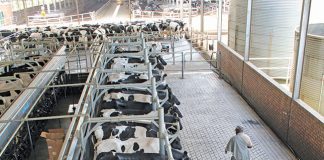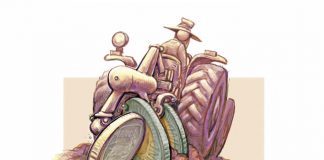
Photo: FW Archive
There is no one-size-fits-all approach to crop protection, according to Rodney Bell, CEO of CropLife South Africa. Fortunately, farmers have a diverse toolbox at their disposal to safely control or manage pests and diseases. They can minimise damage from pests by using state-of-the-art chemical and biological products, advanced data analytics, and precision technologies.
Bell says that implementing an integrated pest management (IPM) programme makes sense.
“Consumers are increasingly demanding food that is produced in a sustainable manner. Farmers need to be more conscious of the pest control methods they apply on their farms and look at implementing an IPM system.
“In many instances, the overuse of chemical pesticides has led to issues such as pesticide resistance, outbreaks of previously suppressed pests, and environmental contamination.
“IPM systems evolved as a response to manage pests in agricultural crops through a combination of biological, cultural, physical and chemical control methods.”
Agricultural consultant Andrew Bennett explains that IPM is an effective and environmentally sensitive approach to pest management that relies on a combination of common-sense practices.
“IPM programmes are based on gathering information on the life cycles of pests and their interaction with the environment, and are used to manage pest damage to crops by the most economical means with the least possible hazard to people and the environment.”
He adds that managing or controlling pests and diseases in this way is a broad-based approach that integrates various practices in an economically viable manner.
“It’s an adaptable system that looks at the most suitable application or action to address the specific problem or need. In the process, each method is evaluated and decisions are based on proper information and applied in a way that makes practical sense.
“Once you understand the concept of IPM, you can make informed decisions about your pest- and disease-control requirements as well as the methods to employ. The end result is a customised approach to pest control that’s based on sustainability.”
Bennett stresses that IPM is not a single pest-control method, but rather a series of actions involving evaluations, decisions and controls that are based on four pillars: threshold determination, prevention, monitoring and control.
Threshold determination
Before any pest-control action is set into motion, the first step should be to set a threshold. This is the point at which pest populations or environmental conditions indicate that pest-control actions are needed. It also indicates the level at which a pest is an economic threat, and is a critical tool guiding pest-control decisions.
Insect monitoring forms an integral part of IPM programmes. It is crucial to detect pests and identify them accurately, so that appropriate control actions can be taken. The use of insect traps is one way of monitoring insect prevalence.
Continual monitoring remains the cornerstone of an IPM programme, regardless of the season.
Monitor and identify pests
Not all insects, weeds and living organisms require control, even in an agricultural setting. Many are innocuous, and some are beneficial.
The aim of a monitoring programme is to identify pests accurately and make appropriate control decisions in conjunction with action thresholds. Monitoring and identification ensure that pesticide is used only when really needed and eliminate the danger of using the wrong kind of pesticide.
“Compare the gathered and recorded information of previous seasons and the current monitoring visits with weather conditions, the pest’s behaviour and developmental stage before making decisions,” advises Bennett.
Prevention
As a first line of pest control, IPM programmes are designed to prevent pests from becoming a threat. In an agricultural crop, this may include using different control measures such as cultivation, crop rotation, selecting pest-resistant varieties, planting pest-free rootstocks and seedlings, releasing natural predators and using various insecticides with different modes of action.
Control
Scouting and monitoring, identification, and action thresholds will indicate if pest control is required. It will also assist in deciding on the correct control method based on efficacy and risk.
Control includes biological, cultural or chemical treatment actions where necessary to prevent major crop damage. Depending on the prevalence of the pest, control may commence using highly targeted chemical pesticides, pheromones to disrupt pest mating, and mechanical control methods such as trapping, cultivation or weeding.
Additional pest-control methods can be employed if further monitoring, insect identification and action thresholds indicate a pressing need.
According to Bell, the broadcast spraying of non-specific pesticides is a last resort. The purpose of pest control is not to get rid of all insects, but to achieve an acceptable or unnoticeable level of damage.
Advantages of an integrated approach
An IPM strategy:
- promotes sound and sustainable agricultural practices;
- reduces environmental risks;
- reduces the potential for air and groundwater contamination;
- protects non-target species;
- reduces the need for harsh chemical pesticides;
- reduces or eliminates issues related to pesticide residue;
- reduces or eliminates re-entry interval restrictions;
- decreases worker, tenant and public exposure to pesticide; and maintains or increases the cost-effectiveness of a pest-management programme.
Biological control, which forms part of an IPM programme, uses living organisms to suppress pest densities. Pest management is focused on using one kind of organism, or ’natural enemy’, to control the pest species. The use of natural enemies in most cases is incorporated into the IPM programmes of farmers.
Protecting the good guys
Most pollinator poisoning occurs when pesticides are applied indiscriminately to flowering crops, pastures or weeds.
Bell provides the following guidelines to control pest insects:
- Scout to determine the economical threshold of the insect damage before spraying.
- Implement biological control methods as part of an IPM system.
- Before making an application, be aware of any pollinators such as honeybees and hives nearby.
- Communicate with neighbouring farmers and beekeepers.
- To reduce bee losses, adhere to the recommendations on the crop-protection-product labels. According to Bell, most problems occur when farmers apply products outside the registration recommendations.
- During the flowering phase of crops and trees, select the least harmful insecticide to bees and other beneficial insects, and spray in the late afternoon or at night.
- Avoid spraying in windy conditions when the spray may drift onto adjacent lands that support foraging bees.
- Avoid using dust products.
- Don’t use herbicides on flowering weeds near the orchards.
- Control weeds before flowering or by mechanical methods such as slashing.
- Keep pesticide use to a minimum while there are hives on a property or when hives are installed permanently. Avoid using pesticides near the hives altogether.
- Educate fieldworkers to ensure that they make informed decisions regarding pesticide applications and follow the instructions on the product labels.
Email Rodney Bell at [email protected], or Andrew Bennett at [email protected].











